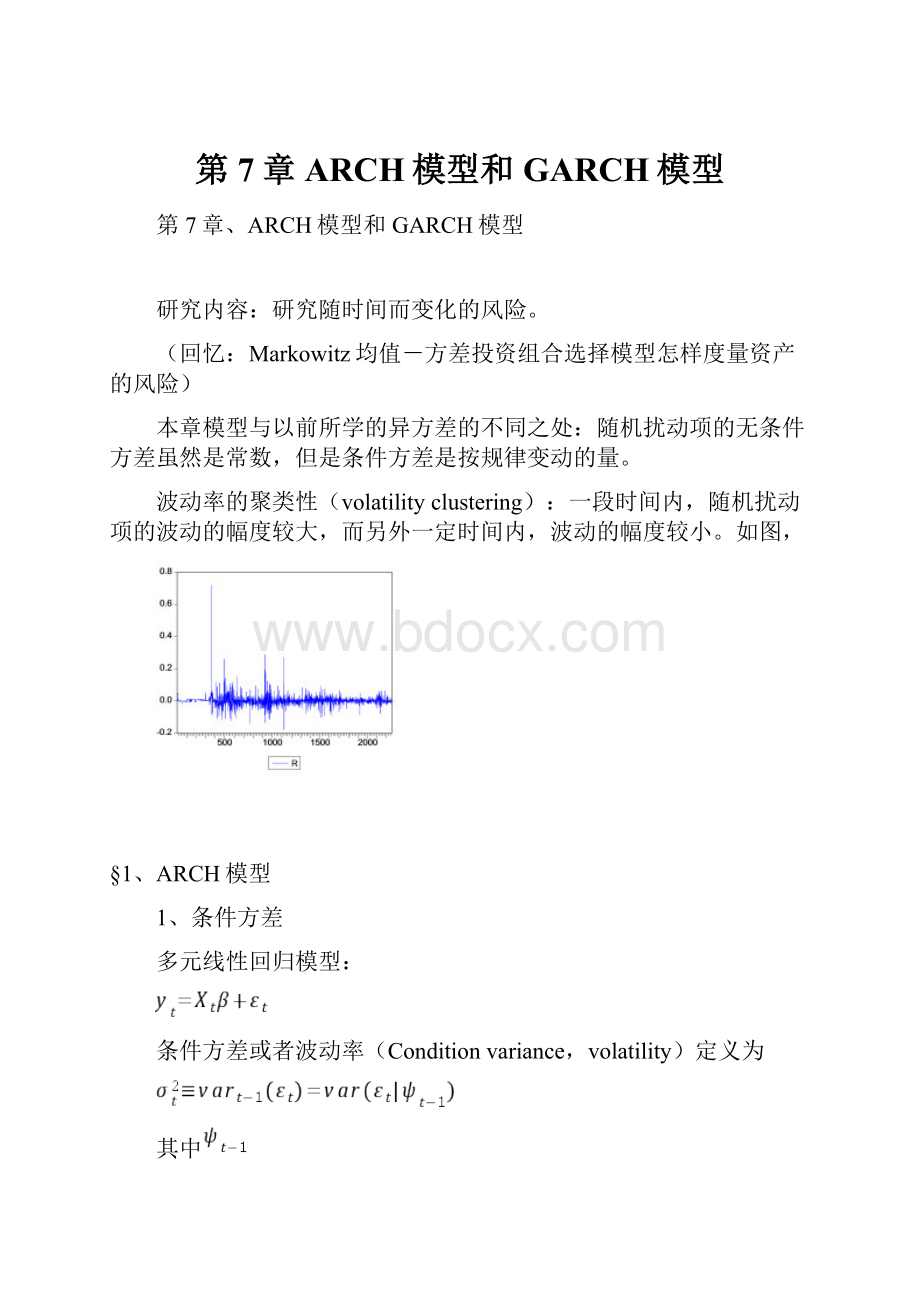第7章ARCH模型和GARCH模型.docx
《第7章ARCH模型和GARCH模型.docx》由会员分享,可在线阅读,更多相关《第7章ARCH模型和GARCH模型.docx(28页珍藏版)》请在冰豆网上搜索。

第7章ARCH模型和GARCH模型
第7章、ARCH模型和GARCH模型
研究内容:
研究随时间而变化的风险。
(回忆:
Markowitz均值-方差投资组合选择模型怎样度量资产的风险)
本章模型与以前所学的异方差的不同之处:
随机扰动项的无条件方差虽然是常数,但是条件方差是按规律变动的量。
波动率的聚类性(volatilityclustering):
一段时间内,随机扰动项的波动的幅度较大,而另外一定时间内,波动的幅度较小。
如图,
§1、ARCH模型
1、条件方差
多元线性回归模型:
条件方差或者波动率(Conditionvariance,volatility)定义为
其中
是信息集。
2、ARCH模型的定义
Engle(1982)提出ARCH模型(autoregressiveconditionalheteroskedasticity,自回归条件异方差)。
ARCH(q)模型:
(1)
的无条件方差是常数,但是其条件分布为
(2)
其中
是信息集。
方程
(1)是均值方程(meanequation)
✓
:
条件方差,含义是基于过去信息的一期预测方差
方程
(2)是条件方差方程(conditionalvarianceequation),由二项组成
✓常数
✓ARCH项
:
滞后的残差平方
习题:
方程
(2)给出了
的条件方差,请计算
的无条件方差。
证明:
利用方差分解公式:
Var(X)=VarY[E(X|Y)]+EY[Var(X|Y)]
由于
,所以条件均值为0,条件方差为
。
那么,
推出
,说明
3、ARCH模型的平稳性条件
在ARCH
(1)模型中,观察参数
的含义:
当
时,
当
时,退化为传统情形,
ARCH模型的平稳性条件:
(这样才得到有限的方差)
4、ARCH效应检验
ARCHLMTest:
拉格朗日乘数检验
建立辅助回归方程
此处
是回归残差。
原假设:
H0:
序列不存在ARCH效应
即
H0:
可以证明:
若H0为真,则
此处,m为辅助回归方程的样本个数。
R2为辅助回归方程的确定系数。
Eviews操作:
①先实施多元线性回归
②view/residual/Tests/ARCHLMTest
§2、GARCH模型的实证分析
从收盘价,得到收益率数据序列。
seriesr=log(p)-log(p(-1))
点击序列p,然后view/linegraph
1、检验是否有ARCH现象。
首先回归。
取2000到2254的样本。
输入lsrc,得到
DependentVariable:
R
Method:
LeastSquares
Date:
10/21/04Time:
21:
26
Sample:
20002254
Includedobservations:
255
Variable
Coefficient
Std.Error
t-Statistic
Prob.
C
0.000432
0.001087
0.397130
0.6916
R-squared
0.000000
Meandependentvar
0.000432
AdjustedR-squared
0.000000
S.D.dependentvar
0.017364
S.E.ofregression
0.017364
Akaikeinfocriterion
-5.264978
Sumsquaredresid
0.076579
Schwarzcriterion
-5.251091
Loglikelihood
672.2847
Durbin-Watsonstat
2.049819
问题:
这样进行回归的含义是什么?
其次,view/residualtests/ARCHLMtest,得到
ARCHTest:
F-statistic
5.220573
Probability
0.000001
Obs*R-squared
44.68954
Probability
0.000002
TestEquation:
DependentVariable:
RESID^2
Method:
LeastSquares
Date:
10/21/04Time:
21:
27
Sample(adjusted):
20102254
Includedobservations:
245afteradjustingendpoints
Variable
Coefficient
Std.Error
t-Statistic
Prob.
C
0.000110
5.34E-05
2.060138
0.0405
RESID^2(-1)
0.141549
0.065237
2.169776
0.0310
RESID^2(-2)
0.055013
0.065823
0.835766
0.4041
RESID^2(-3)
0.337788
0.065568
5.151697
0.0000
RESID^2(-4)
0.026143
0.069180
0.377893
0.7059
RESID^2(-5)
-0.041104
0.069052
-0.595260
0.5522
RESID^2(-6)
-0.069388
0.069053
-1.004854
0.3160
RESID^2(-7)
0.005617
0.069178
0.081193
0.9354
RESID^2(-8)
0.102238
0.065545
1.559806
0.1202
RESID^2(-9)
0.011224
0.065785
0.170619
0.8647
RESID^2(-10)
0.064415
0.065157
0.988613
0.3239
R-squared
0.182406
Meandependentvar
0.000305
AdjustedR-squared
0.147466
S.D.dependentvar
0.000679
S.E.ofregression
0.000627
Akaikeinfocriterion
-11.86836
Sumsquaredresid
9.19E-05
Schwarzcriterion
-11.71116
Loglikelihood
1464.875
F-statistic
5.220573
Durbin-Watsonstat
2.004802
Prob(F-statistic)
0.000001
得到什么结论?
2、模型定阶:
如何确定q
实施ARCHLMtest时,取较大的q,观察滞后残差平方的t统计量的p-value即可。
此处选取q=3。
因此,可以对残差建立ARCH(3)模型。
3、ARCH模型的参数估计
参数估计采用最大似然估计。
具体方法在GARCH一节中讲解。
如何实施ARCH过程:
由于存在ARCH效应,所以点击estimate,在method中选取ARCH
得到如下结果
DependentVariable:
R
Method:
ML-ARCH
Date:
10/21/04Time:
21:
48
Sample:
20002254
Includedobservations:
255
Convergenceachievedafter13iterations
Coefficient
Std.Error
z-Statistic
Prob.
C
-0.000640
0.000750
-0.852888
0.3937
VarianceEquation
C
9.24E-05
1.66E-05
5.569337
0.0000
ARCH
(1)
0.244793
0.082640
2.962142
0.0031
ARCH
(2)
0.081425
0.077428
1.051624
0.2930
ARCH(3)
0.457883
0.109698
4.174043
0.0000
R-squared
-0.003823
Meandependentvar
0.000432
AdjustedR-squared
-0.019884
S.D.dependentvar
0.017364
S.E.ofregression
0.017535
Akaikeinfocriterion
-5.495982
Sumsquaredresid
0.076872
Schwarzcriterion
-5.426545
Loglikelihood
705.7377
Durbin-Watsonstat
2.042013
为了比较,观察将q放大对系数估计的影响
DependentVariable:
R
Method:
ML-ARCH
Date:
10/21/04Time:
21:
54
Sample:
20002254
Includedobservations:
255
Convergenceachievedafter16iterations
Coefficient
Std.Error
z-Statistic
Prob.
C
-0.000601
0.000751
-0.799909
0.4238
VarianceEquation
C
9.38E-05
1.60E-05
5.880741
0.0000
ARCH
(1)
0.262009
0.090256
2.902959
0.0037
ARCH
(2)
0.041930
0.070518
0.594596
0.5521
ARCH(3)
0.452187
0.108488
4.168076
0.0000
ARCH(4)
-0.021920
0.050982
-0.429956
0.6672
ARCH(5)
0.037620
0.044394
0.847408
0.3968
R-squared
-0.003550
Meandependentvar
0.000432
AdjustedR-squared
-0.027830
S.D.dependentvar
0.017364
S.E.ofregression
0.017603
Akaikeinfocriterion
-5.483292
Sumsquaredresid
0.076851
Schwarzcriterion
-5.386081
Loglikelihood
706.1198
Durbin-Watsonstat
2.042568
观察:
说明q选取为3确实比较恰当。
4、ARCH模型是对的吗?
如果ARCH模型选取正确,即回归残差的条件方差是按规律变化的,那么标准化残差就会服从标准正态分布,即不会有ARCH效应了。
为什么?
请思考。
对q为3的ARCH模型做LMtest,发现没有了ARCH效应。
注意,虽然是同一个检验名称,但是ARCH过程后是对标准化残差进行检验。
注意观察被解释变量或者依赖变量是什么?
ARCHTest:
F-statistic
0.238360
Probability
0.992099
Obs*R-squared
2.470480
Probability
0.991299
TestEquation:
DependentVariable:
STD_RESID^2
Method:
LeastSquares
Date:
10/21/04Time:
21:
56
Sample(adjusted):
20102254
Includedobservations:
245afteradjustingendpoints
Variable
Coefficient
Std.Error
t-Statistic
Prob.
C
1.102371
0.264990
4.160043
0.0000
STD_RESID^2(-1)
-0.038545
0.065360
-0.589741
0.5559
STD_RESID^2(-2)
-0.003804
0.065308
-0.058252
0.9536
STD_RESID^2(-3)
-0.057313
0.065303
-0.877649
0.3810
STD_RESID^2(-4)
-0.010325
0.065277
-0.158169
0.8745
STD_RESID^2(-5)
0.003537
0.065280
0.054185
0.9568
STD_RESID^2(-6)
-0.007420
0.065274
-0.113670
0.9096
STD_RESID^2(-7)
0.063317
0.065264
0.970165
0.3330
STD_RESID^2(-8)
-0.012167
0.065293
-0.186340
0.8523
STD_RESID^2(-9)
-0.010653
0.065278
-0.163194
0.8705
STD_RESID^2(-10)
-0.020211
0.065228
-0.309845
0.7570
R-squared
0.010084
Meandependentvar
1.007544
AdjustedR-squared
-0.032221
S.D.dependentvar
2.112747
S.E.ofregression
2.146514
Akaikeinfocriterion
4.409426
Sumsquaredresid
1078.160
Schwarzcriterion
4.566625
Loglikelihood
-529.1546
F-statistic
0.238360
Durbin-Watsonstat
2.000071
Prob(F-statistic)
0.992099
方程整体是不显著的。
还可以观察标准化残差
ARCH建模以后,procs/makeresidualseries/可以产生残差
和标准化残差
,以分别下是残差和标准化残差。
可以看出没有了集群现象。
还可以观察波动率(条件方差)的图形。
对比r和残差的图形,发现条件方差的起伏与波动率的大小一致。
ARCH建模以后,procs/makegarchvarianceseries/得到
结论:
ARCH模型确实很好描述了股票市场收益率的波动性。
可以观察系数之和小于1,满足平稳性条件。
§3、GARCH模型
当q较大时,采用Bollerslov(1986)提出的GARCH模型(GeneralizedARCH)
1、模型定义
条件方差方程
✓均值
✓
✓
:
过去的条件方差(也即预测方差,forecastvariance)
注意:
均值方程中若没有解释变量(即只有常数,如RC),则R2没有直观定义了,因此可为负)
2、GARCH(p,q)模型的稳定性条件
计算扰动项的无条件方差:
GARCH是协方差稳定的,因此是经典回归。
3、GARCH模型的参数估计
采用极大似然估计GARCH模型的参数。
下面以GARCH(1,1)为例。
由GARCH(1,1)模型
可以得到yt的分布为
由正态分布的定义公式,得到yt的pdf为
第t个观察样本的对数似然函数值为
其中
注意yi和yj之间不相关,因而是独立的。
似然函数为
取对数就得到了所有样本的对数似然函数。
其中条件方差项以非线性方式进入似然函数,所以不得不使用迭代算法求解。
4、模型的选择
两条原则:
1)若ARCH(q)中q太大,比如q大于7时,则选择GARCH(p,q)
2)使用AIC和SC准则,选择最优的GARCH模型
3)对于金融时间序列,一般选择GARCH(1,1)就够了。
回顾AIC和SC定义:
1)AIC准则(Akaikeinformationcriterion)
AIC越小越好,结合如下两者:
K(自变量个数)减少,模型简洁
LnL增加,模型精确
2)SC准则(Schwazcriterion)
习题1:
通货膨胀率有ARCH效应吗?
GreeneP572
点击数据文件usinf_greene_p572。
进行回归
lsinflationcinflation(-1)
DependentVariable:
INFLATION
Method:
LeastSquares
Date:
11/19/04Time:
10:
37
Sample(adjusted):
19411985
Includedobservations:
45afteradjustingendpoints
Variable
Coefficient
Std.Error
t-Statistic
Prob.
C
2.432859
0.816345
2.980184
0.0047
INFLATION(-1)
0.493213
0.131157
3.760466
0.0005
R-squared
0.247477
Meandependentvar
4.740000
AdjustedR-squared
0.229976
S.D.dependentvar
4.116784
S.E.ofregression
3.612519
Akaikeinfocriterion
5.450114
Sumsquaredresid
561.1625
Schwarzcriterion
5.530410
Loglikelihood
-120.6276
F-statistic
14.14110
Durbin-Watsonstat
1.612442
Prob(F-statistic)
0.000507
检验ARCH效应
ARCHTest:
F-statistic
0.215950
Probability
0.953308
Obs*R-squared
1.231192
Probability
0.941850
TestEquation:
DependentVariable:
RESID^2
Method:
LeastSquares
Date:
11/19/04Time:
10:
46
Sample(adjusted):
19461985
Includedobservations:
40afteradjustingendpoints
Variable
Coefficient
Std.Error
t-Statistic
Prob.
C
9.270522
7.425567
1.248460
0.2204
RESID^2(-1)
-0.031162
0.170116
-0.183184
0.8557
RESID^2(-2)
-0.006886
0.170151
-0.040469
0.9680
RESID^2(-3)
0.116261
0.169505
0.685888
0.4974
RESID^2(-4)
0.018545
0.170620
0.108694
0.9141
RESID^2(-5)
0.127906
0.168643
0.758439
0.4534
R-squared
0.030780
Meandependentvar
12.28323
AdjustedR-squared
-0.111753
S.D.dependentvar
34.15088
S.E.ofregression
36.00858
Akaikeinfocriterion
10.14287
Sumsquaredresid
44085.00
Schwarzcriterion
10.39620
Loglikelihood
-196.8574
F-statistic
0.215950
Durbin-Watsonstat
1.034796
Prob(F-statistic)
0.953308
习题2:
通货膨胀率有ARCH效应吗?
Lin的数据集
点击usinf文件
seriesdp=100*D(log(p))
lsdpcdp(-1)dp(-2)dp(-3)
DependentVariable:
DP
Method:
LeastSquares
Date:
11/19/04Time:
10:
10
Sample(adjusted):
1951:
11983:
4
Includedobservations:
132afteradjustingendpoints
Variable
Coefficient
Std.Error
t-Statistic
Prob.
C
0.109907
0.063405
1.733410
0.0854
DP(-1)
0.393583
0.084432
4.661536
0.0000
DP(-2)
0.203093
0.089452
2.270405
0.0249
DP(-3)
0.302073
0.084185
3.588214
0.0005
R-squared
0.696825
Meandependentvar
1.021373
AdjustedR-squared
0.689719
S.D.dependentvar
0.711412
S.E.ofregression
0.396277
Akaikeinfocriterion
1.016428
Sumsquaredresid
20.10054
Schwarzcriterion
1.103785
Loglikelihood
-63.08423
F-statistic
98.06599
D